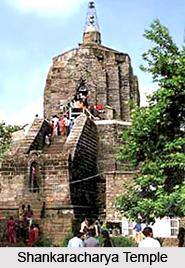 The Shankaracharya Temple, located in the southeast Srinagar, dedicated to Lord Shiva the main temple however is located on the summit of the Takt-e-Suleiman hill overlooking Srinagar town. The Shankaracharya temple dates back to 200 B.C.E although the present structure probably dates back to the 9th century C.E. The temple was apparently visited by the Adi Shankacharya and has ever since been allied with it. The temple lies at an elevation of 1100 feet above surface level of the city.
The Shankaracharya Temple, located in the southeast Srinagar, dedicated to Lord Shiva the main temple however is located on the summit of the Takt-e-Suleiman hill overlooking Srinagar town. The Shankaracharya temple dates back to 200 B.C.E although the present structure probably dates back to the 9th century C.E. The temple was apparently visited by the Adi Shankacharya and has ever since been allied with it. The temple lies at an elevation of 1100 feet above surface level of the city.
Shankaracharya Temple is built on a high octagonal plinth approached by a flight of steps. Shankarachar is a detached ridge of igneous rock to the southeast of Srinagar, separated form the Shilamar Range by the Aita Gaj Gap. The high point of the hill is coroneted with a pretty edifice. This hill was called Jetha Larak and afterwards it was named Gopadri Hill. Some are of the opinion that the temple at the top was originally built by King Sandiman (2629-2564 B.C.). There are 300 golden and silver images housed inside it. Around 1368 B.C. King Gopadittya, founder of Gopkar, revivified the temple and bestowed it to the Brahmans Arya Varta, agrahars that he built on its top. King Sandimati (34 B.C.-A.D. 13) enhanced and added to the Shankaracharya temple`s glory. Zain-Ul-Abdin (1421 1472 A.D.) renovated its roof that had tumbled down due to an earthquake. Sheikh Ghulam Mohi-Din, a Sikh Governor (1841-36) also restored its dome. Recently, the dome was also repaired by Swami Shivratnanand Saraswati at the request of a Nepali sadhu (ascetic) who supplied him with financial aid. The temple is under the control of the Dharmartha Department. They have built two small buildings for the sadhus who live here. There is an old stone shed called the `Parvatihund bana koth` (the store house of Goddess Parvati).
The structure of the Shankaracharya temple boasts architectural technique, reminiscent of prehistorical times. However, many additions and changes have been made to the original structure. Erected on a high octagonal platform, the temple can be reached by a flight of steps. The fencing walls of the steps have inscriptions embedded on them. Inside the Shankaracharya temple, there is s Persian inscription, dating back to the period of Shah Jahan. The main shrine is in the shape of a circular chamber and commands a spectacular view of the valley. After numerous repairs, the ceiling of the main chamber appears to be modern in its approach. The temple is considered as the oldest temple of the valley of Kashmir. Throughout its life, the Shankaracharya temple has faced several chiseled restorations, as is evident from above.





















